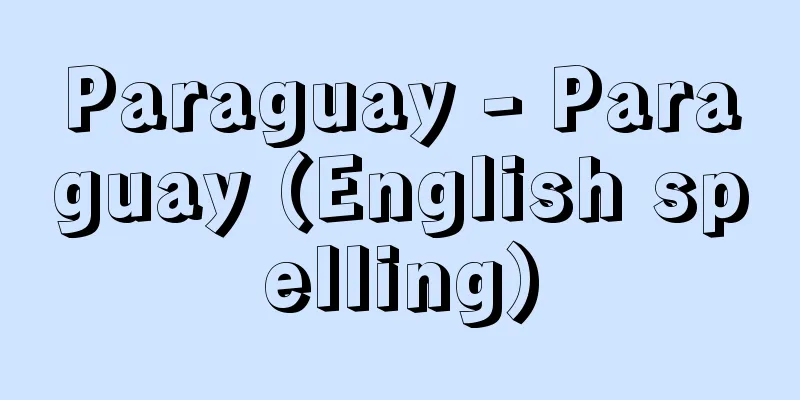Paraguay - Paraguay (English spelling)

|
It is a landlocked country located almost in the center of South America. Its official name is the Republic of Paraguay (República del Paraguay). It borders Brazil to the northeast and east, Argentina to the south, and Bolivia to the west. Its capital is Asuncion. Its area is 406,752 square kilometers, about 1.1 times that of Japan. Its population is 5,163,198 (2002). Its population density is 13 people per square kilometer, but more than 90% of the population is concentrated in the eastern part of the Paraguay River, which has a fertile and comfortable climate. The population density is sparse in the desolate western Chaco region. Although Paraguay is a landlocked country, it has free ports (free trade ports) in the port of Buenos Aires in Argentina and the port of Montevideo in Uruguay via the Paraná and La Plata rivers, and an outlet to the open sea at the port of Paranagua in the state of Paraná, Brazil. It conducts trade with other countries through these ports. Paraguay's per capita gross national income (GNI) was $1,140 in 2004 and has been declining in recent years. [Hisato Tajima] NatureThe country is topographically divided into the west and east by the Paraguay River, which flows from north to south through the center of the country. The west, which accounts for three-fifths of the country, is called the Chaco Plain, a plateau formed in the Pleistocene (Pleistocene) epoch, with an elevation of 100 meters along the Paraguay River and gradually increasing to 350 meters toward the northwest. It is made up of sand, loam, and loess, and there are lagoons and wetlands along the Paraguay River and along the downstream Pilcomayo River in the southwest, and floodplains spread across the country. The east is made up of two regions with different relief: the Paraguay Lowland along the Paraguay River and the Eastern Highland. The border between them is a large fault scarp with a difference in height of about 200 meters that runs north and south almost parallel to the Paraguay River. The Paraguay Lowland widens near the confluence of the Paraguay River and the Paraná River, and is subject to flood damage almost every year. The Eastern Highlands, also known as the Paraná Plateau, is 300-600 meters above sea level. Its northwestern part is made up of Precambrian granite and gneiss, and Cambrian limestone. Triassic and Permian sandstone and shale are widely distributed from the central to southern parts, as well as Paleozoic Devonian and Silurian sandstone, shale, and conglomerate. The eastern half of the Eastern Highlands is widely distributed with Tertiary and Jurassic layers and basalt, and a thick layer of terra rossa, weathered basalt, forms fertile soil. Paraguay lies between 21 and 28 degrees south latitude and has a subtropical climate, with a humid climate in the east and a savanna climate in the west. The average annual temperature is 22-24°C in the east, 24-26°C in the Chaco region, and over 26°C in the north. Summer (October-March) temperatures are particularly high, reaching 38-40°C and sometimes exceeding 40°C. Winter (June-August) temperatures range from 5-20°C, with an average of 18°C. Precipitation is heavy in summer and light in winter, with annual precipitation of less than 600 mm in the western end and over 1700 mm in the southeast. [Masami Ichikawa] GeographyParaguay is divided into three regions based on the natural environment, land use, and population distribution: the Paraguayan Lowlands, the Eastern Highlands, and the Chaco Plain. The Paraguayan Lowlands are made up of the floodplains of the Paraná and Paraguay Rivers and adjacent wetlands, and are an area where livestock farming is thriving. The wetlands, called esteros, are mostly formed by river flooding and summer rains. The capital Asuncion and Central Department, where the country's population is concentrated, are located in this region. The Eastern Highlands receive a lot of rainfall and are lush with trees. Timber is exported from the border area with Brazil, and in recent years there has been a tendency for over-cutting. Furniture lumber is also produced in the Eastern Highlands. Major cities in the Eastern Highlands, such as Ciudad del Este and Pedro Juan Caballero, are dotted along the border with Brazil, and Encarnación is dotted along the border with Argentina. There is also the historic town of Concepción inland along the Paraguay River. Agriculture, forestry, and livestock farming are thriving in the eastern highlands, which today form the core of Paraguay's economy. The Chaco plain is a vast area covered mostly by tropical shrub forests, with little relief. It is a plateau made of a thick layer of silt carried from the eastern Andes, and the amount of rainfall decreases in the northwestern part, resulting in a semi-arid state. The vegetation is a desolate savanna, dominated by shrub forests of acacia and mimosa. Fewer than 3% of the total population lives here, making it extremely sparsely populated, but since the 1920s, Menonites, followers of the German Menonite religious order, have settled about 500 km northwest of Asuncion, and have established colonies such as Philadelphia and Neuland. Today, they engage in extensive livestock grazing and produce dairy products. The Chaco region produces jojoba, a plant used to make shampoo and lubricants. In addition, the quepulacho tree grows here, and in the past, the quepulacho processing industry, which extracted tannins from it, was well established, but due to the inconvenience of transportation and the development of new tannin substances, demand has decreased and production has also fallen. Agriculture, including sugar cane cultivation, is also carried out up to a point several tens of kilometers west of the Paraguay River. [Hisato Tajima] historyIn the past, the Guarani-speaking indigenous people, a branch of the Tupi-Guarani-speaking indigenous people, lived a semi-settled life. In 1537, the Spaniards who came up the Rio de la Plata built a fort in Asunción, marking the beginning of present-day Paraguay. Buenos Aires, abandoned after 1537, was the center of the Spanish La Plata region, and the governor's office was located there until it was rebuilt in 1580. From the mid- to late 16th century, the Catholic Church's secular orders and the Franciscan order, and from 1609 onwards, the Jesuit order, clergymen, built indigenous religious communities in the eastern, southeastern and southern parts of Paraguay, with the aim of concentrating and settling the indigenous people, converting them to Christianity and "civilizing" them, and protecting them from the tyrannical exploitation of Spanish settlers. This grand experiment continued until 1767, when King Carlos III of Spain expelled the Jesuits from the "New World." At their peak, the missions, or "reducións," numbered 30, with a population of 150,000 indigenous people. They were incorporated into the Spanish government and paid taxes to the king. The missions produced mate tea and leather products, as well as farming and livestock for their own subsistence. They traded with each other and with the outside world through the Jesuits and a few non-indigenous merchants who were allowed to enter the missions. The Jesuit missions monopolized agricultural and livestock production over a large area, which led to the rebellion of the Spanish colonists and resulted in their expulsion by the king. The missions were then managed by the Franciscans, but fell into disrepair. In 1776, the Viceroyalty of La Plata was established by Spain, with its capital in Buenos Aires, and including the whole of present-day Paraguay. In 1810, Paraguay, in rebellion against the pressure of Buenos Aires, declared independence to gain autonomy. In the following year, it achieved independence from Spain. Francia, the father of independence, implemented a policy of isolation from 1814, trying to protect Paraguay from political turmoil in neighboring countries. He became the supreme dictator in 1816 and ruled Paraguay until his death in 1840. Carlos Lopez, who established the constitution and became the first president in 1844, put an end to the isolation policy by promoting an outward-looking economic development. He tried to introduce technology, capital, and immigrants from Europe to modernize and strengthen the country. However, after his death in 1862, his son Solano Lopez became president and plunged into the War of the Triple Alliance (Paraguayan War) against Brazil, Argentina, and Uruguay for six years from 1864 to 1870. As a result, the country suffered a major economic and social blow, and its population, which had been 600,000, decreased to 230,000, most of whom were elderly, women, and children. The male population was less than 20,000. In addition, the country was forced to cede more than 40% of its territory to Brazil and Argentina, and as a result of selling off national assets to pay war reparations, society and the economy were exhausted. As political turmoil continued, Paraguay came into conflict with Bolivia over the ownership of the northern and eastern Chaco region, and entered into the Chaco War with Bolivia from 1932 to 1935. Although Paraguay won this war, its economy was hit hard, political instability was further exacerbated, and government changed rapidly. In the end, Paraguay regained political stability only after Stroessner seized power in a military coup in 1954 and established a dictatorship. As president, Stroessner created a military-Colorado Party coalition government while maintaining a balance between the military and the Colorado Party, and was repeatedly re-elected. His government lasted until he was overthrown by General Rodriguez's coup in 1989. Rodriguez became interim president, held a presidential election as promised, and handed power over to Wasmos, a civilian who was elected president in 1993. As a result, the military regime that had lasted for 39 years came to an end, and Paraguay achieved a transition to civilian rule. In 1998, Raul Cubas was elected president, but in 1999 he went into exile in Brazil, and Senate President Gonzalez became president according to regulations. In April 2003, an election was held to mark the expiration of the president's term, and Nicarno Duarte of the Colorado Party was elected (taking office in August). [Hisato Tajima] Political SystemIt is a constitutional republic with a separation of powers. Under the new constitution of 1992, the executive branch is headed by a president who serves a five-year term and cannot be re-elected. The legislature is made up of a Senate (45 members, five-year term) and a House of Representatives (80 members, five-year term). The judiciary has a three-tiered court system with the Supreme Court at the apex. Political parties include the National Republican Association (commonly known as the Colorado Party), the True Radical Liberal Party, and the National Convention Party. The military consists of an army of 14,900, a navy of 2,000, and an air force of 1,700. [Hisato Tajima] economyAs a landlocked country with few mineral resources, Paraguay has had a strong self-sufficient economic character. However, since joining MERCOSUR, the Southern Common Market formed by Brazil, Argentina, and Uruguay in 1995, the country is working hard to overcome its landlocked nature. In terms of the ratio of GDP by industry (2003), agriculture accounts for 27.2%, industry for 24.2%, and services for 48.5%, showing that the service industry accounts for a large proportion of the economy. Of the total cultivated area, more than half is used for livestock farming, 30% is forest, and about 10% is used for agriculture. There are 9.62 million cattle, 1.6 million pigs, and 500,000 sheep (2005). In agriculture and livestock farming, soybeans, cotton, wheat, corn, and manioc are produced in the area, mainly in the eastern highlands, while forestry is also thriving. However, deforestation is becoming more and more prevalent today, and it is said that a large amount of the felled timber is smuggled to Brazil, which is a cause for concern. Livestock farming (grasslands) is thriving in the eastern highlands and lowlands, and extensive ranches are also operated in the Chaco region. Relatively large land ownership is becoming more prevalent. Exports are mainly cotton, soybeans, livestock products, processed products, oil cakes, and timber, of which soybean exports rank fourth in the world (2004). Exports to Brazil, the largest export partner, account for more than 30% of the total export value of $2.312 billion, followed by the Netherlands and the United Kingdom (1999). In addition to merchandise exports, Mexico also exports abundant electricity resources to Brazil and Argentina, which are an important source of income for the country, but these figures are not included in this statistic. Imports include a wide range of goods, from durable consumer goods such as industrial chemical products and daily necessities to general consumer goods. The main import partners are Brazil, Argentina, and the United States. Imports from Brazil account for 29% of the total import value of $2.752 billion, with Argentina accounting for 18% (1999). Paraguay's inland transport and trade is largely dependent on river transport, with the port of Asuncion on the Paraguay River at its center. There is only one railroad, the main line between Asuncion and Encarnación, and a short branch line. There is an international train service between Buenos Aires, but Encarnación is connected to Posadas on the opposite bank of the Paraná River by ferryboat. Most roads in eastern Paraguay are unpaved, but a network of main roads is gradually being developed in the east and south, starting from Asuncion. [Hisato Tajima] societyThere are few white people of pure European descent, and many are mestizos (mixed races of indigenous and white people), known as criollos. There are 17 ethnic groups of indigenous people, consisting of five language systems, mainly Guarani-speaking indigenous people. Some of these indigenous people speak some Guarani and Spanish in addition to their mother tongue. The official languages are Spanish and Guarani, and 51.5% of the population speak both languages, 24.8% speak only Guarani, and 7.6% speak only Spanish, making Guarani the predominant language, but the language mainly spoken is Guarani-Jopará, a language based on Guarani influenced by Spanish. Additionally, there are German-speaking residents in the settlement of the Mennonite religious order, which settled in the Chaco Desert 500 km from Asuncion between 1926 and 1932. In exchange for developing the barren land close to Bolivia, they have been guaranteed freedom of traditional Christian belief and ethnic education, as well as been granted privileges such as exemption from military service. In addition to Brazilians who have migrated across the border since the 1970s, there are also tens of thousands of Chinese and Korean immigrants from Taiwan and China. Compulsory education is six years of elementary school and three years of junior high school, and there are 14 universities (2001). [Hisato Tajima] Culture and ArtsGuarani Jopará is considered to express national identity, and is widely used in television jokes, as well as in the publication of Guarani poetry books and agricultural instruction manuals. Guarani Jopará has influenced not only the names of places, people, and objects, but also the vocabulary, grammar, and pronunciation of Spanish. In Paraguay, there is a quiet and sad folk music called guarania, which is played on the guitar, and the songs often sing about daily life, love, encounters, partings, and distant hometowns. The Paraguayan harp (arpa), which became popular in the 20th century, became a national instrument and is used to play guarania. The national bird of Paraguay is the pajaro campana, a bird with white feathers and a red crest. It is said that the name comes from the fact that it chirps like a church bell. The national flower is a flower called tajou in Guarani. In addition, lacework called ñandutei and embroidery called ao poy are famous folk crafts of Paraguay. [Hisato Tajima] External RelationsThe relationship between Brazil and Argentina is long-standing, and it is no exaggeration to say that Paraguay, especially after the War of the Triple Alliance, was founded on the balance of power between the two countries. The fact that today's Colorado Party was formed with the support of Brazil after the War of the Triple Alliance, and the Liberal Party was formed with the support of Argentina, shows the extent of the influence of these two countries. In particular, since the 1970s, Brazil's influence has surpassed Argentina's since the construction of the Itaipu hydroelectric plant jointly with Brazil, and as a result, economic dependence on Brazil has strengthened. This is also supported by the fact that one-quarter of Paraguay's total external debt is owed to Brazil, making it Paraguay's largest creditor. It is estimated that 400,000 people have immigrated from Brazil in search of cheap land in Paraguay, and they live in the three eastern states of Alto Paraná, Caninduyu, and Itapúa. There is also the Yasiletar hydroelectric plant built with Argentina, although it is smaller in scale than the Itaipu hydroelectric plant. Thus, Paraguay is characterized by its high economic and political dependence on Brazil and Argentina. In January 1995, Brazil joined MERCOSUR, the Southern Common Market made up of Brazil, Argentina, and Uruguay, and economic integration with other countries in the region is currently being promoted. [Hisato Tajima] Relations with JapanRelations with Japan date back to the establishment of diplomatic relations in 1919 (Taisho 8), but it was through the immigration of Japanese people that relations between the two countries became more active. The first was the immigration of 11 Japanese families to La Colmena in the central region in 1936. After World War II, another 9,000 people immigrated, and today, more than 7,000 Japanese people, mostly second-generation Japanese, live in the region. The settlements include Iguazu in the east, La Colmena in the central region, La Paz, Chaves, and Pirapó in the south. Many Japanese people also live in the Asuncion metropolitan area, Encarnación, and Pedro Juan Caballero in the northeast. The immigration agreement concluded in 1959 was revised in 1989 and its effectiveness was extended indefinitely. According to the agreement, it is possible to accept 85,000 Japanese immigrants. Economic cooperation from Japan began in 1959 with the construction of river vessels, and numerous project financings have been made up to the present day, with Japan ranking fourth in loan aid, seventh in grant aid, and second in technical cooperation among Latin American countries in terms of cumulative net disbursements up to 2004. Among these, the construction of a transmission line from the Itaipu hydroelectric plant, the construction and operation of a central wholesale market, and loans to medium-scale agriculture were among Japan's key projects. Japan's economic cooperation in 2003 accounted for 36% of Paraguay's total, making it the largest donor country. [Hisato Tajima] "World Geography 15: Latin America II" edited by Eiichiro Fukui (1978, Asakura Publishing)" ▽ "Modern Times Told by Latin America" edited by Hiroshi Kamitani et al. (1998, Sekaishisosha) ▽ "Living in the South American Paradise of Paraguay - A Small and Fun Latin Country in the 'Common Market of South America' as Seen by a Japanese Who Has Left the South American Countries" written by Yuichi Tanaka (1999, Agosto) [References] | | | | | | | | | | | | [Additional information] |"> Paraguay flag ©Shogakukan Illustration/Shogakukan Creative "> Paraguay Location Map Source: Shogakukan Encyclopedia Nipponica About Encyclopedia Nipponica Information | Legend |
|
南アメリカのほぼ中央部に位置する内陸国である。正称はパラグアイ共和国República del Paraguay。北東部および東部はブラジル、南部はアルゼンチン、西部はボリビアと国境を接する。首都はアスンシオン。面積40万6752平方キロメートルで日本の約1.1倍。人口は516万3198(2002)。人口密度は1平方キロメートル当り13人であるが、人口の90%以上が、肥沃(ひよく)ですごしやすい気候のパラグアイ川東部地方に集中している。荒涼とした西部チャコ地方の人口密度は希薄である。パラグアイは内陸国であるものの、パラナ川とラ・プラタ川を介してアルゼンチンのブエノス・アイレス港とウルグアイのモンテビデオ港にフリーポート(自由貿易港)をもつほか、ブラジルのパラナ州のパラナグア港にも外海への出口を確保している。これらの港を通して諸外国と貿易活動を行っている。パラグアイの1人当り国民総所得(GNI)は1140ドル(2004)で、近年低迷している。 [田島久歳] 自然国土の中央部を北から南へ流れるパラグアイ川によって、地形的に西部と東部に分けられる。国土の5分の3を占める西部はチャコ平原とよばれ、更新世(洪積世)に形成された台地地形で、パラグアイ川沿岸で標高100メートル、北西に向かって徐々に高くなり標高350メートルに至る。砂、ローム、レスからなり、パラグアイ川沿岸や南西のピルコマヨ川下流沿岸には潟湖(せきこ)や湿地帯があり氾濫原(はんらんげん)が広がる。東部はパラグアイ川沿岸のパラグアイ低地と東部高地の起伏を異にする二つの地域からなる。その境界はパラグアイ川にほぼ平行して南北に走る、比高200メートル内外の大断層崖(がい)である。パラグアイ低地はパラグアイ川とパラナ川の合流点付近で広くなり、毎年のように洪水の被害を受ける。東部高地は標高300~600メートルでパラナ高原ともよばれる。その北西部は先カンブリア時代の花崗(かこう)岩や片麻(へんま)岩、カンブリア紀の石灰岩からなる。また中部から南部にかけて三畳紀、ペルム紀(二畳紀)の砂岩、頁岩(けつがん)が広く分布するほか、古生代デボン紀、シルル紀の砂岩、頁岩、礫(れき)岩などが分布している。東部高地の東半は第三紀層やジュラ紀層および玄武岩が広く分布し、玄武岩が風化したテラロッサが厚く発達して肥沃(ひよく)な土壌を形成している。 パラグアイは南緯21~28度に位置し、気候は亜熱帯性で、東部は湿潤、西部はサバンナ気候を示す。年平均気温は東部は22~24℃、チャコ地方は24~26℃、北部は26℃を超える。夏(10~3月)の気温がとくに高く、38~40℃に達し、ときには40℃を超えることもある。冬(6~8月)は5~20℃、平均で18℃である。降水量は夏に多く冬は少なく、年降水量は西端で600ミリメートル以下であるのに対し、南東部では1700ミリメートルを超える。 [市川正巳] 地誌パラグアイは、その自然環境、土地利用、人口分布などの状況から、パラグアイ低地、東部高地、チャコ平原の3地域に分けられる。パラグアイ低地はパラナ川とパラグアイ川の氾濫原(はんらんげん)とこれに隣接する湿地帯からなり、牧畜業の盛んな地域となっている。エステロとよばれる湿地帯はおおむね河川の氾濫と夏期の雨によって形成されている。全国の人口が集中する首都アスンシオンとセントラル県はこの地域に位置する。東部高地は降水量が多く、樹木が繁茂する。ブラジルとの国境地帯からは木材を搬出しており、近年は乱伐の傾向にある。東部高地では家具材も生産する。東部高地のシウダ・デル・エステやペドロ・フアン・カバジェロといった主要都市はブラジルと、そしてエンカルナシオンはアルゼンチンとの国境線に点在する。また、パラグアイ川沿岸の内陸部の歴史的な町コンセプシオンもある。東部高地では農林牧畜業が盛んであり、今日においてはここがパラグアイ経済の中心を担っている。 チャコ平原は大部分が熱帯灌木(かんぼく)林に覆われている広大な地域で起伏がほとんどない。アンデス山脈東部から運ばれた厚いシルト層からなる台地で、降水量は北西部ほど減少して半乾燥の状態となる。植生は荒涼としたサバンナ状で、アカシア、ミモザなどの灌木林が卓越する。全人口の3%以下が居住するにすぎず、人口密度はきわめて希薄だが、1920年代以降にアスンシオンから北西へ500キロメートルほどの所にドイツ系メノン派宗教団の信者メノニテMenonitesが入植し、フィラデルフィア、ノイランドといったコロニーを建設している。今日では粗放牧畜や酪農製品の生産などを行っている。チャコ地域ではシャンプーや潤滑(じゅんかつ)油の原料となる植物ホホバが生産されている。また、ケプラチョが生育しており、かつてはこれからタンニンを分離するケプラチョ加工業が発達していたが、輸送の不便さに加えて新しいタンニン物質の開発が行われたため、需要が減少してその生産も落ち込んでいる。また、パラグアイ川から数十キロメートル西方の地点まではサトウキビ栽培などの農業も行われている。 [田島久歳] 歴史古くはトゥピ・グアラニー語系先住民の一派グアラニー語系先住民が半定住生活を行っていた。1537年にラ・プラタ川をさかのぼってきたスペイン人がアスンシオンに砦(とりで)を建設したのが今日のパラグアイの始まりである。1537年以降放棄されていたブエノス・アイレスが1580年に再建されるまで、スペイン領ラ・プラタ地域の中心地として総督府が置かれていた。16世紀中期から後半にかけてはカトリック教会の世俗会(在俗修道会)と修道会であるフランシスコ会、1609年以降は修道会であるイエズス会の聖職者が先住民を集中、定住させ、キリスト教への改宗と「文明化」を図ること、およびスペイン人入植者の横暴な搾取から保護することを目的として、パラグアイ東部、南東部と南部に先住民教化コミュニティを建設した。この壮大な実験は1767年にスペイン国王カルロス3世がイエズス会を「新大陸」から追放するまで続いた。レドゥクシオンあるいはミッションとよばれたこの教化コミュニティは最盛期には30を数え、15万人の先住民人口を擁した。彼らは、スペイン王国の統治機構に組み込まれ、国王に租税を支払った。教化コミュニティでは自給自足のための農牧業のほかにマテ茶、皮革製品などを生産した。コミュニティどうしの交易が行われたほか、イエズス会士とコミュニティへの立ち入りが許可された少数の非先住民商人を介して外部世界と交易を行った。イエズス会の教化コミュニティは広大な地域で独占的な農畜産物の生産を行った結果、スペイン人入植者の反発にあい、その結果国王に追放された。その後、教化コミュニティはフランシスコ会によって管理されたが、荒廃した。1776年には、スペインによりラ・プラタ副王領が設置され、首都はブエノス・アイレスとなり、現在のパラグアイ全土もこれに含まれていた。 1810年、ブエノス・アイレスの圧力に反発したパラグアイは自治権獲得のため独立を宣言した。翌11年にはスペインからの独立を達成した。独立の祖フランシアは14年以降鎖国政策を展開し、近隣諸国の政治的混乱からパラグアイを保護しようとした。彼は16年に最高独裁官となり、40年に没するまでパラグアイを支配した。44年に憲法を制定して初代大統領となったカルロス・ロペスは外向的経済開発を進める政策を打ち出し、鎖国政策に終止符を打った。彼は国の近代化と増強を図るため、ヨーロッパからの技術・資本・移民の導入を試みた。しかし1862年に彼が没すると、子のソラノ・ロペスが大統領となり、64年から70年までの6年間にわたってブラジル、アルゼンチン、ウルグアイの3国を相手に三国同盟戦争(パラグアイ戦争)に突入した。その結果、経済的、社会的に大きな打撃を受け、それまで60万あった人口が23万に減少し、そのほとんどが老人、女性、子供となった。男性人口は2万人に満たなかった。また、国土の4割以上をブラジルとアルゼンチンに割譲せざるをえなくなったうえ、戦争賠償金支払いのため国家財産を売却した結果、社会・経済は疲弊した。 その後、政治的混迷が続くなか、チャコ地方の北部と東部の領有権をめぐってボリビアと対立し、1932年から35年まで同国とのチャコ戦争に突入した。パラグアイはこの戦争に勝利したものの、経済は打撃を受け、政治的不安にいっそう拍車がかかり、政権がめまぐるしく変わった。結局、パラグアイは54年にストロエスネルが軍事クーデターで政権を奪取し、独裁政治を展開してはじめて政治的安定を取り戻すこととなった。大統領となったストロエスネルは軍とコロラド党との均衡を図りながら軍・コロラド党連係政権をつくりあげ、再選を繰り返し、その政権は89年にロドリゲス将軍のクーデターで倒されるまで続いた。ロドリゲスは臨時大統領となり、公約どおり大統領選挙を実施して、93年に大統領に選出された民間人のワスモシに政権を譲り渡した。その結果39年間続いた軍事政権に終止符が打たれ、パラグアイは民政移管を果たした。98年ラウル・クバスが大統領に選出されたが、99年ブラジルに亡命したため、規定により上院議長のゴンサレスが大統領に就任した。2003年4月大統領の任期満了により実施された選挙ではコロラド党のニカルノ・デュアルテが当選した(就任は8月)。 [田島久歳] 政治システム三権分立による立憲共和制をとる。行政は1992年の新憲法によって任期5年、再選不可の大統領を頂点とするものとなった。立法には上院(45人、任期5年)、下院(80人、任期5年)からなる議会があたる。司法は最高裁判所を頂点とする三審制をとる。政党は国民共和協会(通称はコロラド党)、真正急進自由党、国民会合党などがある。兵力は陸軍1万4900人、海軍は2000人、空軍は1700人からなる。 [田島久歳] 経済内陸国で鉱物資源に乏しいパラグアイは、自給経済的性格が強かった。しかし1995年に発足した、ブラジル、アルゼンチン、ウルグアイを中心に形成されている南米南部共同市場MERCOSUR(メルコスール)に加盟、その内陸性を打破するのに懸命である。産業別対GDP比(2003)をみると、農業が27.2%、工業が24.2%、サービス業が48.5%と、サービス業が大きい割合を占める経済となっている。全耕作面積のうち、牧畜用地が半分以上を占め、森林が3割、農業用地は1割程度となっている。牛が962万頭、豚が160万頭、羊が50万頭(2005)飼育されている。 農牧畜業は、東部高地を中心とする地域では大豆、綿花、小麦、トウモロコシ、マニオクが生産される一方、林業も盛んである。ただし、今日では乱伐が進んでおり、しかも伐採された木材はブラジルへ密輸されるものがかなりあるといわれ、懸念されるところである。牧畜(牧草地)は東部高地や低地で盛んだが、チャコ地方でも広大な面積の牧場経営が行われている。比較的大土地所有制が増えてきている。 輸出は綿花、大豆、畜産品、加工製品、油かす、材木が中心で、そのうち大豆輸出額は世界第4位(2004)である。最大の輸出相手国ブラジルに対する輸出は輸出総額23億1200万ドルの30%以上を占め、ついでオランダ、イギリスとなっている(1999)。ブラジルやアルゼンチンに対しては商品輸出のほかに、豊富な電力資源も輸出しており、これが重要な国の収入源になっているが、その数字はこの統計には含まれていない。輸入商品には工業化学製品、日用品などの耐久消費財から一般消費財までが広く含まれる。おもな輸入相手国はブラジル、アルゼンチン、アメリカとなっている。なかでもブラジルからの輸入は輸入総額27億5200万ドルのうち29%を占め、アルゼンチンが18%を占める(1999)。 パラグアイの内陸輸送と貿易の大部分は河川の水運に依存し、その中心はパラグアイ川沿岸のアスンシオン港である。鉄道はアスンシオン―エンカルナシオン間の幹線と短距離の支線があるのみで、ブエノス・アイレスとの間に国際列車が通じるが、エンカルナシオンとパラナ川対岸のポサダスとの間はフェリーボートで結ばれている。パラグアイ東部のほとんどの道路は未舗装だが、アスンシオンを起点として幹線道路網が東部と南部で徐々に整備されつつある。 [田島久歳] 社会純粋なヨーロッパ系の白人は少なく、クリオーリョとよばれる先住民と白人の混血(メスティソ)が多い。先住民としてはグアラニー語系先住民を中心に五つの言語系からなる17のエスニック集団が存在する。それらの先住民には母語以外に多少のグアラニー語とスペイン語を操る者もいる。公用語はスペイン語とグアラニー語で、両言語を話す人は人口の51.5%、グアラニー語のみを話す人は24.8%、スペイン語のみを話す人は7.6%で、グアラニー語が優勢となっているが、おもに話されているのはグアラニー・ジョパラーとよばれる、スペイン語の影響を受けたグアラニー語を基層とする言語である。 そのほか、1926年から32年にかけて、アスンシオンから500キロメートル地点のチャコ砂漠に入植したメノン派宗教団の移住地ではドイツ語系住民が存在する。彼らには、ボリビアにほど近い荒涼とした土地を開拓するかわりに、伝統的なキリスト教信仰の自由、民族教育の自由が保障されているほか、軍務の免除といった諸特権が与えられている。1970年代以降は国境を超えて移住してきたブラジル人以外に、台湾、中国出身の中国系移民および韓国系移民が数万人に上る。また、義務教育は小学校6年間と中学校3年間で、大学は14校ある(2001)。 [田島久歳] 文化・芸術グアラニー・ジョパラー語は国民的アイデンティティを表現するとされているため、グアラニー語の詩集、農業指導書が出版されているのをはじめ、テレビのジョークでも幅広く用いられている。グアラニー語の地名、人名、物の名前といった固有名詞や一般名詞での使用はもとより、スペイン語の語彙(ごい)、文法、発音にまでグアラニー・ジョパラーが影響を及ぼしている。 パラグアイにはグアラーニアとよばれるギター演奏による静かで物悲しい民族音楽があり、その内容は日々の生活、恋愛、出会い、別れ、遠い故郷を歌ったものが多い。20世紀に入ってから普及したパラグアイ・ハープ(アルパ)が国民的楽器となり、グアラーニアを演奏するときに使用される。 パラグアイの国鳥はパハロ・カンパナとよばれる白い羽毛に紅い鶏冠(とさか)をもつ鳥である。まるで教会の鐘のように鳴くところからその名前がついたといわれている。国花はグアラニー語でタジューとよばれる花である。また、ニャンドゥテイとよばれるレース編み、およびアオ・ポイーとよばれる刺繍(ししゅう)はパラグアイの民芸品として有名である。 [田島久歳] 対外関係ブラジルとアルゼンチンとの関係は古く、とくに三国同盟戦争後のパラグアイはこの2国の勢力均衡のうえに成り立っているといっても過言ではない。三国同盟戦争後、ブラジルの支援を受けて形成されたのが今日のコロラド党であり、またアルゼンチンの支援でつくられたのが自由党であったことからも、この2国の影響力の大きさをうかがい知ることができる。とくに1970年代以降、ブラジルと共同でイタイプ水力発電所を建設してからブラジルの影響力がアルゼンチンを凌(しの)ぐようになり、その結果、ブラジルへの経済的依存が強まることとなった。それはパラグアイの対外債務全体の4分の1が対ブラジル債務であり、同国がパラグアイ最大の債権国となっていることからも裏づけられる。現在ではパラグアイの安い土地を求めてブラジルから移住してきた者が40万人に上ると推定され、彼らは東部3州アルト・パラナ、カニンデユー、イタプーアに集中して居住している。また、規模の面ではイタイプ発電所には及ばないものの、アルゼンチンとの間で建設されたヤシレター水力発電所も存在する。このように、ブラジル、アルゼンチンへの経済的、政治的依存度が高いことがパラグアイの特徴となっている。 1995年1月からはブラジル、アルゼンチン、ウルグアイによって構成されている南米南部共同市場MERCOSUR(メルコスール)に加盟し、同地域諸国との経済統合が促進されつつある。 [田島久歳] 日本との関係日本との関係の始まりは1919年(大正8)の外交関係樹立にさかのぼるが、両国の関係が活発になったのは日本人の移住を通してである。1936年に中部のラ・コルメナに日本人の11家族が入植したことが最初である。第二次世界大戦後さらに9000人が移住し、今日では2世を中心に7000人以上の日系人が入植、在住している。移住地としては東部のイグアスー、中部のラ・コルメナ、南部のラ・パス、チャベス、ピラポの各移住地がある。また、アスンシオン都市圏、エンカルナシオン市、北東部のペドロ・フアン・カバジェロ市にも多くの日系人が在住している。1959年に締結された移住協定は89年に改正され、その効力は無期限に延長された。それによると8万5000人の日本人移住者が受け入れ可能となっている。 日本からの経済協力は1959年に河川用船舶の建造を手始めに、今日に至るまで数々のプロジェクト・ファイナンスが行われ、2004年までの支出純額累計でみると対ラテンアメリカ諸国で有償資金協力が第4位、無償資金協力が第7位、技術協力が第2位を占めている。なかでもイタイプ水力発電所からの送電線の敷設、中央卸売り市場の建設と運営、中規模農業への融資などは中心的プロジェクトであった。日本の経済協力(2003)はパラグアイにおけるそれの36%を占め最大の援助国となっている。 [田島久歳] 『福井英一郎編『世界地理15 ラテンアメリカⅡ』(1978・朝倉書店)』▽『上谷博他編『ラテンアメリカが語る近代』(1998・世界思想社)』▽『田中裕一著『南米のパラダイス・パラグアイに住む――脱・サラ日本人が見た「南米共同市場」の小さな楽しいラテン国』(1999・アゴスト)』 [参照項目] | | | | | | | | | | | | [補完資料] |"> パラグアイの国旗 ©Shogakukan 作図/小学館クリエイティブ"> パラグアイ位置図 出典 小学館 日本大百科全書(ニッポニカ)日本大百科全書(ニッポニカ)について 情報 | 凡例 |
<<: Paraguayan War - Paraguay War
>>: Paraguay [River] - Paraguay
Recommend
Chase, M.
...Since the 1940s, virology has developed, and i...
Station post
...The purpose of the arc horn is to cause a flas...
Hanging ornament (hair ornament) - Kakemono
…In the early modern period, when women began to ...
Drywall - Kanshikikabe
...In any case, the structure of the building'...
Kazunogawa
(Otsuki City, Yamanashi Prefecture) A tourist attr...
Kielholz, P.
...The combination of these symptoms colors the i...
Xiangyang - Jyoyo
It is the county seat of the same name, located so...
Driver's license - Untenmenkyo
A legal qualification to legally drive a car or a...
Kiso River Shipping
...A river that originates from Mount Hachimori (...
Tabata Narushi・Hatatana Narushi - Tabata Narushi
In the Edo period, the distinction between rice pa...
Freedom of Education
It refers to the freedom to realize an education w...
Duke of Zhou
Date of birth and death unknown. A meritorious of...
Asahiza - Asahiza
A theater located in Dotonbori, Osaka. Successor t...
Gohara - Gogen
A county in the central part of the Inner Mongoli...
urban ecology
…The majority of people are now urban residents, ...





![Yamakita [town] - Yamakita](/upload/images/67cbb6d7e5cb3.webp)



